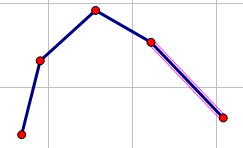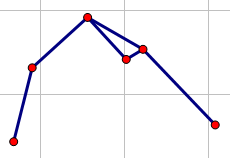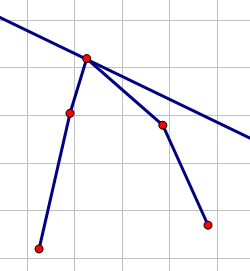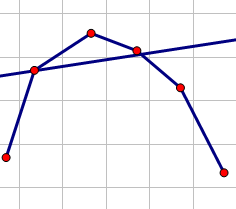NOI 2007 货币兑换Cash (bzoj 1492) - 斜率优化 - 动态规划 - CDQ分治
Description
.png)
.png)
Input
Output
只有一个实数MaxProfit,表示第N天的操作结束时能够获得的最大的金钱数目。答案保留3位小数。
Sample Input
1 1 1
1 2 2
2 2 3
Sample Output
HINT
.png)
题目大意 每天可以根据一定比例购买或者卖出纪念劵。问最多在$n$天后可以得到多少钱。
由题意易得,一定存在一种最优的方案满足,能买时就全买,能卖时就全卖。因为如果要赚就要尽可能地多赚,会亏就一点都不去碰。
设$f[i]$表示第$i$天后把手上的纪念劵都卖掉后可以得到最多的钱,于是轻松地列出了dp方程:
$f[i] = \max\left \{ \frac{f[j]\left ( r_{j}A_{i} + B_{i} \right )}{r_{j}A_{j} + B_{j}}, f[i - 1] \right \}$
暂时先不管$\max$,当成等式,两边同除以$B_{i}$。
$\frac{f[i] }{B_{i}}= \frac{f[j]\left ( r_{j}\frac{A_{i}}{B_{i}} + 1 \right )}{r_{j}A_{j} + B_{j}}$
然后移移项什么的。。
$\frac{f[i] }{B_{i}}= \frac{f[j]r_{j}}{r_{j}A_{j} + B_{j}}\cdot \frac{A_{i}}{B_{i}}+\frac{ f[j]}{r_{j}A_{j} + B_{j}}$
$\frac{ f[j]}{r_{j}A_{j} + B_{j}}=- \frac{f[j]r_{j}}{r_{j}A_{j} + B_{j}}\cdot \frac{A_{i}}{B_{i}}+\frac{f[i] }{B_{i}}$
(第二步是把和$j$相关的扔到等号左边去,当做$y$,把形如$M\left(i\right)N\left(j \right )$,扔到左边,把其中的$M\left(i\right)$看作常数项,把$N\left(j \right )$看作$x$)
所以有:
$x_{i} = \frac{r_{i}f[i]}{r_{i}A_{i} + B{i}},y_{i}=\frac{f[i]}{r_{i}A_{i} + B{i}}$
然后可得:
$y_{j} = -\frac{A_{i}}{B_{i}}x_{j} + \frac{f[i]}{B_{i}}$
因为要最大化$f[i]$,所以应该最大化截距。所以维护上凸壳。
同时方程也可以写成:
$f[i] =\max\left \{ A_{i}x_{j}+B_{i}y_{j}, f[i - 1] \right \}$
考虑如何来求最大的截距。
因为这里插入点的$x$坐标不单调,询问的斜率也不单调,所以不能开单调队列暴力移指针了。
Solution 1 平衡树维护动态凸壳
(这是什么啊?可以吃吗?)
最后维护的凸壳是要长这个样子:

由于边不是很稳定,因为插入或者删除一个点,维护边的信息很麻烦。。。所以考虑用平衡树维护点,如果能够找到前驱后继,那么就可以轻松地找到边的信息。
由于要能找到边的信息,所以将点按照横坐标进行排序。
为了更好地偷懒,所以假设第0个点连接第1个点的直线的斜率为$inf$,最后一条点的后一条直线斜率为$-inf$
考虑插入一个点。
向左向右分别找到第一个能与它组成凸壳的点(即满足斜率递减,对于它前面的点来说就是,满足连接点$pre$的前驱和$pre$的直线的斜率大于连接点$pre$和当前点的直线的斜率)
显然这个东西可以二分。其实是不用的。。。(时间复杂均摊有保证,每个点被访后要么成为了要的点,结束了操作,要么被删了,所以时间复杂度$O\left(n\right)$)
当然还需要判断一下,这种情况

这种的话,只需要看看前面的点和后面的点以及当前点是否合法,不合法就说明当前点不该加入,否则就把它加入凸包。
至于如何维护前驱后继?
其实很简单,因为只在插入和删除的时候会发生改变,就在那个时候维护一下就好了。
现在考虑要在凸壳上找一个点,使得一条斜率为$k$的直线经过它,并且截距最大。
(这玩意儿显然可以三分)

显然,当直线于凸壳相切(或者和凸壳的某一条边重合)的时候截距最大。不如一个不相切的情况:

显然可以通过平移使得它更优。
考虑什么时候相切呢?当经过的点的前一条直线的斜率大于等于$k$,以及它的后一条直线的斜率小于等于$k$时。
这个显然可以二分。于是剩下的就是代码的问题。。
(注意精度问题。。)
Code

1 /** 2 * bzoj 3 * Problem#1492 4 * Accepted 5 * Time: 1160ms 6 * Memory: 11468k 7 */ 8 #include <bits/stdc++.h> 9 using namespace std; 10 typedef bool boolean; 11 #define pnn pair<TreapNode*, TreapNode*> 12 #define fi first 13 #define sc second 14 15 const double eps = 1e-7; 16 17 int dcmp(double x) { 18 if(fabs(x) < eps) return 0; 19 return (x > 0) ? (1) : (-1); 20 } 21 22 typedef class TreapNode { 23 public: 24 double x; 25 double y; 26 int rd; 27 TreapNode *l, *r; 28 TreapNode *pre, *suf; 29 }TreapNode; 30 31 #define Limit 200000 32 33 TreapNode pool[Limit]; 34 TreapNode *top = pool; 35 36 TreapNode* newnode(double x, double y) { 37 top->x = x, top->y = y; 38 top->l = top->r = NULL; 39 top->rd = rand(); 40 return top++; 41 } 42 43 typedef class DynamicConvexHull { 44 public: 45 TreapNode* root; 46 47 DynamicConvexHull():root(NULL) { } 48 49 pnn split(TreapNode* p, double x) { 50 if(!p) return pnn(NULL, NULL); 51 pnn rt; 52 if(p->x - eps > x) { 53 rt = split(p->l, x); 54 p->l = rt.sc, rt.sc = p; 55 } else { 56 rt = split(p->r, x); 57 p->r = rt.fi, rt.fi = p; 58 } 59 return rt; 60 } 61 62 TreapNode* merge(TreapNode* a, TreapNode* b) { 63 if(a == NULL) return b; 64 if(b == NULL) return a; 65 if(a->rd > b->rd) { 66 a->r = merge(a->r, b); 67 return a; 68 } 69 b->l = merge(a, b->l); 70 return b; 71 } 72 73 double slope(TreapNode* a, TreapNode* b) { 74 if(a == NULL) return 1e100; 75 if(b == NULL) return -1e100; 76 if(!dcmp(a->x - b->x)) 77 return (dcmp(a->y - b->y) == -1) ? (1e100) : (-1e100); 78 return (a->y - b->y) / (a->x - b->x); 79 } 80 81 TreapNode* findPre(TreapNode* p, TreapNode* np) { 82 TreapNode* rt = NULL; 83 while(p) { 84 if(slope(p->pre, p) - eps > slope(p, np)) 85 rt = p, p = p->r; 86 else 87 p = p->l; 88 } 89 return rt; 90 } 91 92 TreapNode* findSuf(TreapNode* p, TreapNode* np) { 93 TreapNode* rt = NULL; 94 while(p) { 95 if(slope(np, p) - eps > slope(p, p->suf)) 96 rt = p, p = p->l; 97 else 98 p = p->r; 99 } 100 return rt; 101 } 102 103 void insert(double x, double y) { 104 TreapNode* pn = newnode(x, y); 105 pnn pr = split(root, x); 106 TreapNode* pre = findPre(pr.fi, pn); 107 TreapNode* suf = findSuf(pr.sc, pn); 108 pn->pre = pre, pn->suf = suf; 109 if(slope(pre, pn) - eps >= slope(pn, suf)) { 110 pr.fi = (pre) ? (split(pr.fi, pre->x + eps + eps).fi) : (NULL); 111 pr.sc = (suf) ? (split(pr.sc, suf->x - eps - eps).sc) : (NULL); 112 if(pre) pre->suf = pn; 113 if(suf) suf->pre = pn; 114 pr.fi = merge(pr.fi, pn); 115 } 116 root = merge(pr.fi, pr.sc); 117 } 118 119 TreapNode* query(double k) { 120 TreapNode* p = root, *rt = NULL; 121 double cur, cmp; 122 while(p) { 123 cur = slope(p->pre, p); 124 if(cur - eps >= k) { 125 if(!rt || cur + eps < cmp) 126 rt = p, cmp = cur; 127 p = p->r; 128 } else 129 p = p->l; 130 } 131 return rt; 132 } 133 134 // void debugOut(TreapNode* p) { 135 // if(!p) return; 136 // debugOut(p->l); 137 // cerr << "(" << p->x << ", " << p->y << ")" << endl; 138 // debugOut(p->r); 139 // } 140 }DynamicConvexHull; 141 142 int n; 143 double *A, *B, *rate; 144 double *f; 145 DynamicConvexHull dch; 146 147 inline void init() { 148 scanf("%d", &n); 149 A = new double[(n + 1)]; 150 B = new double[(n + 1)]; 151 f = new double[(n + 1)]; 152 rate = new double[(n + 1)]; 153 fill(f, f + n + 1, 0.0); 154 scanf("%lf", f); 155 for(int i = 1; i <= n; i++) 156 scanf("%lf%lf%lf", A + i, B + i, rate + i); 157 } 158 159 inline void solve() { 160 f[1] = f[0]; 161 double y = f[1] / (rate[1] * A[1] + B[1]); 162 double x = rate[1] * y, k; 163 dch.insert(x, y); 164 for(int i = 2; i <= n; i++) { 165 k = -A[i] / B[i]; 166 TreapNode* rt = dch.query(k); 167 f[i] = A[i] * rt->x + B[i] * rt->y; 168 f[i] = max(f[i], f[i - 1]); 169 y = f[i] / (rate[i] * A[i] + B[i]); 170 x = y * rate[i]; 171 dch.insert(x, y); 172 } 173 printf("%.3lf\n", f[n]); 174 } 175 176 int main() { 177 init(); 178 solve(); 179 return 0; 180 }
Solution 2 CDQ分治
考虑当前要求出$[l, r]$中的dp值。
根据CDQ分治的常用套路,考虑左区间对右区间的贡献。
假设现在已经成功计算出左区间中的dp值,并将这些状态按照横坐标排序。
那么就可以用单调队列维护静态凸壳把左区间的凸壳建出来。
将右区间按照询问的斜率从大到小排序。
于是,这就变成了最智障的斜率优化问题了。。
但是$O\left ( n\log^{2}n \right )$会不会T掉?
考虑计算右区间的时候并不需要按照横坐标排序,而是按照询问的斜率排序。
所以,在分治前按照询问的斜率排序,然后在回溯的过程中按照横坐标进行归并。
于是成功去掉一个$\log$,总时间复杂度$O\left ( n\log n \right )$
但是因为自带大常数,比别人的Splay慢好多,sad....
Code
1 /** 2 * bzoj 3 * Problem#1492 4 * Accepted 5 * Time: 1208ms 6 * Memory: 8732k 7 */ 8 #include <bits/stdc++.h> 9 using namespace std; 10 typedef bool boolean; 11 12 const double eps = 1e-7; 13 14 int dcmp(double x) { 15 if(fabs(x) < eps) return 0; 16 return (x > 0) ? (1) : (-1); 17 } 18 19 typedef class Query { 20 public: 21 double k; 22 int id; 23 24 boolean operator < (Query b) const { 25 return k > b.k; 26 } 27 }Query; 28 29 int n; 30 double *A, *B, *rate; 31 double *xs, *ys; 32 double *f; 33 Query *qs, *qbuf; 34 int* sta; 35 36 inline void init() { 37 scanf("%d", &n); 38 A = new double[(n + 1)]; 39 B = new double[(n + 1)]; 40 rate = new double[(n + 1)]; 41 xs = new double[(n + 1)]; 42 ys = new double[(n + 1)]; 43 f = new double[(n + 1)]; 44 qs = new Query[(n + 1)]; 45 qbuf = new Query[(n + 1)]; 46 sta = new int[(n + 1)]; 47 scanf("%lf", f); 48 for(int i = 1; i <= n; i++) { 49 scanf("%lf%lf%lf", A + i, B + i, rate + i); 50 qs[i].k = -A[i] / B[i], qs[i].id = i; 51 } 52 } 53 54 double slope(int s, int t) { 55 if(dcmp(xs[s] - xs[t]) == 0) return (1e100); 56 return (ys[t] - ys[s]) / (xs[t] - xs[s]); 57 } 58 59 boolean cmpPoint(int a, int b) { 60 int d = dcmp(xs[a] - xs[b]); 61 return (d == -1 || (d == 0 && dcmp(ys[a] - ys[b]) == -1)); 62 } 63 64 void CDQDividing(int l, int r, int L, int R) { 65 if(l == r) { 66 f[l] = max(f[l], f[l - 1]); 67 xs[l] = rate[l] * f[l] / (rate[l] * A[l] + B[l]); 68 ys[l] = f[l] / (rate[l] * A[l] + B[l]); 69 return; 70 } 71 72 int mid = (l + r) >> 1, qL = L - 1, qR = mid; 73 74 for(int i = L; i <= R; i++) 75 if(qs[i].id <= mid) 76 qbuf[++qL] = qs[i]; 77 else 78 qbuf[++qR] = qs[i]; 79 for(int i = L; i <= qR; i++) 80 qs[i] = qbuf[i]; 81 CDQDividing(l, mid, L, qL); 82 83 int pl = 1, pr = 0, t = L; 84 for(int i = L; i <= qL; i++) { 85 while(pr - pl > 0 && dcmp(slope(sta[pr - 1], sta[pr]) - slope(sta[pr], qs[i].id)) != 1) pr--; 86 sta[++pr] = qs[i].id; 87 } 88 89 for(int i = mid + 1, id; i <= R; i++) { 90 id = qs[i].id; 91 while(pr - pl > 0 && dcmp(qs[i].k - slope(sta[pl], sta[pl + 1])) == -1) pl++; 92 f[id] = max(f[id], A[id] * xs[sta[pl]] + B[id] * ys[sta[pl]]); 93 } 94 95 CDQDividing(mid + 1, r, mid + 1, R); 96 97 pl = L, pr = mid + 1; 98 while(pl <= qL || pr <= R) { 99 if((pr > R) || (pl <= qL && cmpPoint(qs[pl].id, qs[pr].id))) 100 qbuf[t++] = qs[pl++]; 101 else 102 qbuf[t++] = qs[pr++]; 103 } 104 for(int i = L; i <= R; i++) 105 qs[i] = qbuf[i]; 106 } 107 108 inline void solve() { 109 sort(qs + 1, qs + n + 1); 110 fill(f + 1, f + n + 1, 0); 111 CDQDividing(1, n, 1, n); 112 printf("%.3lf\n", f[n]); 113 } 114 115 int main() { 116 init(); 117 solve(); 118 return 0; 119 }

